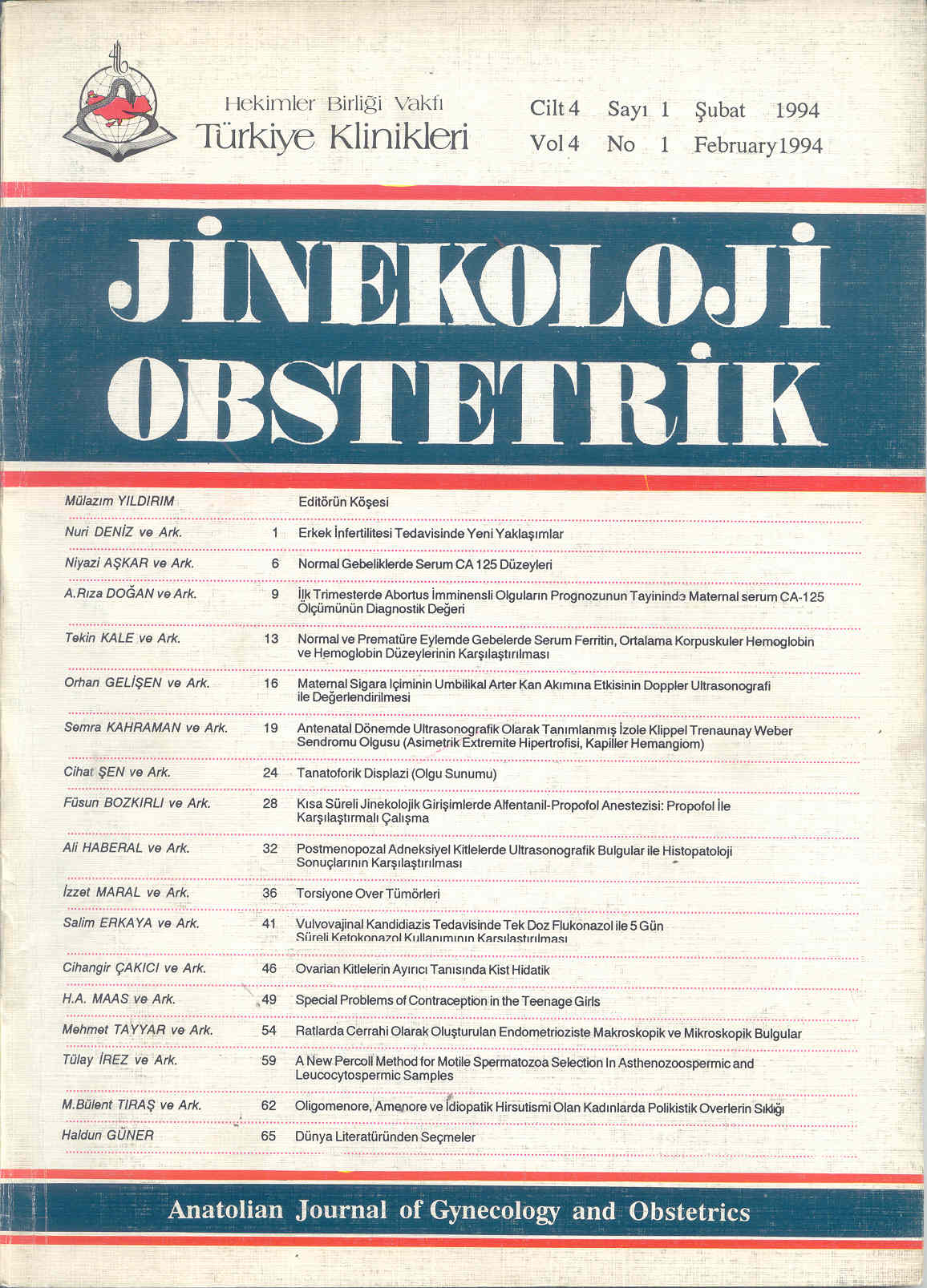Open Access
Peer Reviewed
ARTICLES
3293 Viewed980 Downloaded
A New Percoll Method for Motile Spermatozoa Selection in Asthenozoospermic and Leucocytospermic Samples
Astenospermik Ve Lökositospermik Örneklerde Motil Spermatozoaları Ayırt Etmek İçin Yeni Bir Percoll Metodu
Turkiye Klinikleri J Gynecol Obst. 1994;4(1):59-61
Article Language: TR
Copyright Ⓒ 2025 by Türkiye Klinikleri. This is an open access article under the CC BY-NC-ND license (http://creativecommons.org/licenses/by-nc-nd/4.0/)
ÖZET
Amaç: Motil spermleri ayırmak için üç farklı yıkama tekniği karşılaştırıldı. Çalışmanın Yapıldığı Yer: Cerrahpaşa Tıp Fakültesi, Kadın Hastalıkları ve Doğum AD, İstanbul. Materyel ve Metod: Astenospermik ve lökositospermik semen örnekleri laboratuarda 3 eşit miktara ayrıldı. Bu örnekler swim up, aralıklı percoll gradient ve %40'lık percoll ile yıkandı. Bulgular: Bir saatlik inkübasyon zamanından sonra swim up ve aralıklı percoll gradient tekniklerinin spermin hareket parametrelerine etkisi arasında fark olmadığı, buna karşılık 400 rpm sentrifugasyonda yapılan %40'lık percoll tekniğinin motiliteyi anlamlı olarak arttırdığı tespit edildi. Sonuç: Buna göre %40'lık percoll tekniğinin özellikle astenospermik ve lökositospermik örneklerde motil spermleri ayırt etmek için kullanılması tavsiye edilir.
Amaç: Motil spermleri ayırmak için üç farklı yıkama tekniği karşılaştırıldı. Çalışmanın Yapıldığı Yer: Cerrahpaşa Tıp Fakültesi, Kadın Hastalıkları ve Doğum AD, İstanbul. Materyel ve Metod: Astenospermik ve lökositospermik semen örnekleri laboratuarda 3 eşit miktara ayrıldı. Bu örnekler swim up, aralıklı percoll gradient ve %40'lık percoll ile yıkandı. Bulgular: Bir saatlik inkübasyon zamanından sonra swim up ve aralıklı percoll gradient tekniklerinin spermin hareket parametrelerine etkisi arasında fark olmadığı, buna karşılık 400 rpm sentrifugasyonda yapılan %40'lık percoll tekniğinin motiliteyi anlamlı olarak arttırdığı tespit edildi. Sonuç: Buna göre %40'lık percoll tekniğinin özellikle astenospermik ve lökositospermik örneklerde motil spermleri ayırt etmek için kullanılması tavsiye edilir.
ANAHTAR KELİMELER: Human spermatozoa, asthenozoospermia, leucocytospermia, percoll, swim up
ABSTRACT
Objective: Three tehniques for the separation of motile spermatozoa were compared. Institution: Cerrahpaşa Medical Faculty, Department of Gynecology and Obstetrics, İstanbul. Material and Methods: Ejaculates were collected from asthenozoospermic and leucocytospermic patients. The samples were divided into there aliquots of equal volume. Each of them was processed by the swim up migration, centrifugation on a discontinuos percoll gradient and centrifugation on a 40% of percoll. Their respective effects on sperm motility were analyzed. Findings: In three groups, there was no difference in any of the motion parameters between the swim up or discontinuous difference in motility and in the number of normal forms was observed after 40% percent percoll in 400 rpm centrifugation. Results:We conclude that, with this modification the technique of 40% percent of percoll in 400 rpm used for the separation of human spermatozoa is strongly advised especially in asthenozoospermic and leucocytospermic samples.
Objective: Three tehniques for the separation of motile spermatozoa were compared. Institution: Cerrahpaşa Medical Faculty, Department of Gynecology and Obstetrics, İstanbul. Material and Methods: Ejaculates were collected from asthenozoospermic and leucocytospermic patients. The samples were divided into there aliquots of equal volume. Each of them was processed by the swim up migration, centrifugation on a discontinuos percoll gradient and centrifugation on a 40% of percoll. Their respective effects on sperm motility were analyzed. Findings: In three groups, there was no difference in any of the motion parameters between the swim up or discontinuous difference in motility and in the number of normal forms was observed after 40% percent percoll in 400 rpm centrifugation. Results:We conclude that, with this modification the technique of 40% percent of percoll in 400 rpm used for the separation of human spermatozoa is strongly advised especially in asthenozoospermic and leucocytospermic samples.
MENU
POPULAR ARTICLES
MOST DOWNLOADED ARTICLES





This journal is licensed under a Creative Commons Attribution-NonCommercial-NoDerivatives 4.0 International License.










